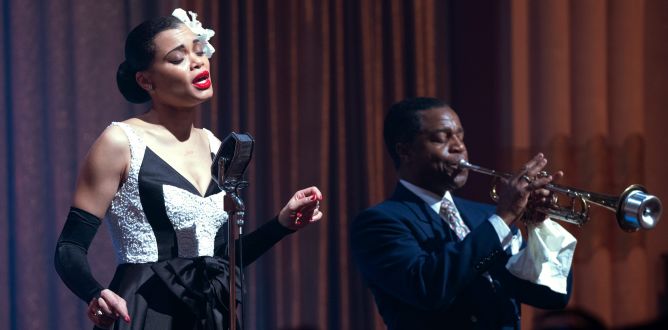The United States vs. Billie Holiday Parent Guide
Instead of telling the expected story of racial prejudice, this film gives drug addiction a lead role.
Parent Movie Review
Jazz singer Billie Holiday is perhaps best known for Strange Fruit. The song combines her sensual sound, a mysterious melody and haunting lyrics (written by Lewis Allan: AKA Abel Meeropol) that describe the corpse of a lynched black man swinging from a poplar tree in America’s south. It was a provocative piece in 1939 when the African American vocalist recorded it. During her lifetime Holiday continued to cause controversies whenever she performed it. And its disturbing message still resonates today.
In this movie, Andra Day plays Billie Holiday, beginning when her career is in full swing and her signature number, Strange Fruit, is requested by cheering fans. But not everyone loves Black artists, jazz music or the song that shines a spotlight on a violent form of racial terror.
Holiday’s voice challenges the White establishment in general and Harry Anslinger (Garrett Hedlund) in particular. Yet they can’t legally silence Holiday’s freedom of expression. As head of the FBN (Federal Bureau of Narcotics), which has declared a war on drugs, Anslinger comes up with a clever tactic to quiet the squeaky wheel. From inside sources he knows Holiday is an addict. Given the authority by the government to stalk and arrest users, Anslinger has the perfect excuse to target Holiday and stop the music – all the while looking like a hero fighting societal ills.
To accomplish his goal, Anslinger sends an agent (Trevante Rhodes) to infiltrate Holiday’s private life and gather enough evidence to incarcerate her. The audience also gets a backstage pass to Holiday’s turbulent past, abusive lovers, embezzling managers, personal betrayals and rampant substance use. Preparing and injecting drugs, guzzling alcohol and smoking are frequently shown. Full nudity, simulated sex, brutal beatings and life in a brothel are portrayed. The aftermath of a lynching includes seeing a hanging corpse, weeping family members and a burning cross. These depictions are quite graphic and accompanied by persuasive profanity. All-in-all, it is hard to watch.
If you were expecting a story about racial prejudice, you may be confused as that issue becomes a background player in a movie that makes drug addiction its leading lady. The focus adjustment may not be as much of a surprize to those familiar with Chasing the Scream: The First and Last Days of the War on Drugs by Johann Hari, which is the source novel for the film. The book uses Holiday’s story to illustrate why addiction should not be treated as a crime. Likewise, Suzan-Lori Parks’ adapted screenplay paints a sympathetic picture of the addict, partly by exploring some of the reasons why Holiday may have begun using drugs in the first place. Yet as it delves deeper into the cycle of abuse, the script is consumed by the destructive consequences of Holiday’s habit and poor relationship choices, until the bigotry she faces is overshadowed by her personal tragedy. Unintentionally, The United States vs. Billie Holiday ends up feeling more like Billie Holiday vs. Billie Holiday.
Despite this battle of agendas, for me the real crime is how the movie becomes so lost in objectionable material and foul language that neither of its messages will be accessible to younger audiences. (I am not advocating sugar-coating the truth. I just believe the story could have been effectively told by implying, rather than depicting, the gritter details.) And that is important because the only hope for building future interracial respect and extending compassion for those caught in addiction is to pass these ideals onto the next generation.
Directed by Lee Daniels. Starring Andra Day, Trevante Rhodes, and Garrett Hedlund. Running time: 130 minutes. Theatrical release February 26, 2021. Updated October 2, 2021
The United States vs. Billie Holiday
Rating & Content Info
Why is The United States vs. Billie Holiday rated Not Rated? The United States vs. Billie Holiday is rated Not Rated by the MPAA
Violence: The film includes archival lynching photos with victims hanging from trees. A song’s lyrics describe what a person looks like after being hung. A scene depicts a family reacting to the killing of a loved one: A person tries to release the body that is hanging from a tree, while young children wail with grief, a cross is set ablaze and property damage has occurred. An angry man grabs a woman by the throat and pushes her into a mirror, then tosses her to the floor and kicks her. Other scenes of abuse include verbal threats, hitting and demeaning. Characters are betrayed by others, including having drugs planted on them before a police raid. Racial discrimination is depicted, with Black people being treated differently or targeted by White authority figures.
Sexual Content: Full female nudity, front and back, is seen in several scenes - some sexual and some non-sexual. A woman strips and taunts federal agents who want to search her for drug possession. A naked woman is hosed down by female guards in a prison shower room. A man roughly removes a woman’s clothes and begins to have sex with her – moaning, fondling, forceful-handling (his hand on her throat, pushing her into furniture) and property damage are depicted. In another scene a woman defies a man to have sex with her: he takes her up on the offer and sexual activity depicted. A child wanders through a brothel looking for her mother: prostitutes in various stages of sexual engagement with male clients are seen. The mother encourages her young daughter to fondle a man (this is a conversation only). The rape of a child and prostitution are mentioned. A man wears a woman’s clothing. A woman’s breasts are seen when she wraps up her injured ribs after being beaten by her boyfriend. A character is asked about a lesbian relationship. The trailer for the movie shows two women about to kiss – but this content is not included in the final cut of the film.
Profanity: Pervasive use of strong sexual expletives (sometimes in a sexual context) and racial slurs (sometimes between members of the same ethnic group, and other times as a derogatory slight). Other profanity, sexual slang and terms of deity are also heard.
Alcohol / Drug Use: Characters are frequently shown drinking and smoking. Drug use is frequently depicted including preparing and the injecting narcotics and purchasing products form pushers. Character’s arms show nasty marks from where needles have been inserted. A character who cannot get a fix becomes angry with others.
Page last updated October 2, 2021
The United States vs. Billie Holiday Parents' Guide
Learn more about these real people who are depicted in this movie:
Listen to Billie Holiday sing Strange Fruit. (Copyright: Reelin’ In The Years Archives, Billie Holiday - “Strange Fruit” Live 1959)
Loved this movie? Try these books…
This film is based on the book Chasing the Scream: The First and Last Days of the War on Drugs by Johann Hari.
For more about the artist’s life and music, you can turn to John Szwed’s biography Billie Holiday: The Musician and the Myth.
If you want to share the message of “Strange Fruit” with youngsters but don’t want to expose the to the negative content of the film, you can read Strange Fruit: Billie Holiday and the Power of a Protest Song. Written by Gary Golio and illustrated by Charlotte Riley-Webb, this book is suitable for middle school readers.
Home Video
Related home video titles:
The director of this movie was also the creative force behind Lee Daniels’ The Butler.
Tallulah Bankhead, who is mentioned in this film, was an actress. She can be seen in the 1944 Alfred Hitchcock classic, Lifeboat.


